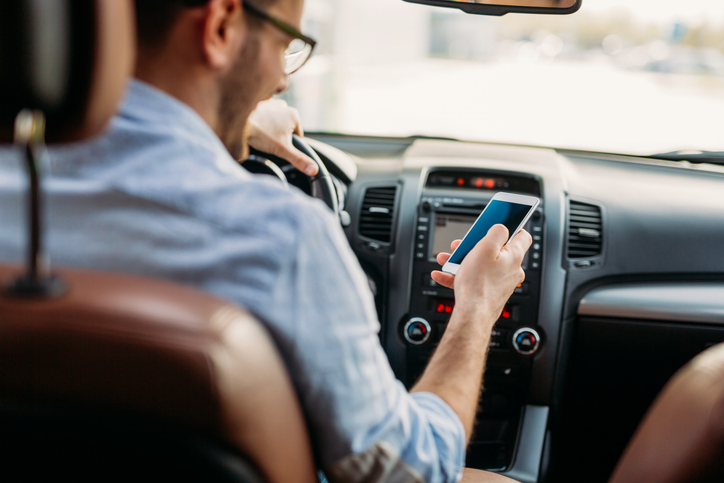Distracted Driving and Cellphones
Posted July 12, 2024
Distracted driving is a significant cause of motor vehicle crashes that result in costly property damage and threaten safety. According to the National Highway Traffic Safety Administration (NHTSA), in 2022, 3,308 people were killed, and an estimated additional 289,310 were injured in motor vehicle crashes that involved distracted drivers. Additionally, the NHTSA reported that 621 nonoccupants, including pedestrians and cyclists, were killed in distraction-affected traffic crashes that year.
These statistics demonstrate the risks of distracted driving and exhibit the need for businesses to do their part and take steps to make the roadways safer. Fortunately, these types of distracted driver incidents are preventable. One way they can do so is by promoting strategies to restrict employee cellphone use while driving. In fact, the NHSTA found that an estimated 26,151 individuals were injured in traffic crashes involving cellphone use or other activities related to the devices in 2022. This article discusses the dangers of using a cellphone while driving and explores strategies businesses may adopt to prevent these risks.
 Cellphone Use While Driving Dangers
Cellphone Use While Driving Dangers
Cellphone use while driving can create many distractions that can lead to crashes. These hazards can be broken down into the following distraction categories:
- Visual—Using a cellphone can divert a driver’s eyes from the road. For example, the NHTSA states that sending or reading a text for five seconds while going 55 mph would be akin to a driver driving the length of a football field with their eyes closed.
- Auditory—Cellphones can create many sounds and noises that distract drivers. Although the most apparent example may be a conversation on a device, cellphones can also create auditory distractions through alarms, ringtones, notifications or other alerts.
- Physical—Anything that causes a driver to take one or both hands off the wheel is a physical distraction. Examples of cellphone-related physical distractions include picking up and using a phone to call, text, program the GPS, read emails or use other apps.
- Cognitive—Even if a driver is using the cellphone hands-free, conversations can create cognitive distractions or activities that cause a driver to shift their focus away from driving. Cognitive distractions can lead to “inattentional blindness,” or when an individual does not perceive a visible but unexpected object that is in plain sight.
While some cellphone activities fall into one category, others may cause distractions that involve multiple categories. Regardless of their classification, cellphone use while driving can pose significant risks to drivers and others using roadways.
Preventing Cellphone Use While Driving
Employers have a duty to provide a safe working environment for employees, so they must take steps to prevent the risks cellphones create for their drivers and others on the road. Consider these strategies:
- Maintain clear policies. Businesses should have clear, written policies that state drivers may not use cellphones while driving, and they should have details on how infractions of this policy may result in the loss of driving privileges.
- Vet drivers. Thoroughly vetting drivers’ backgrounds and motor vehicle records before allowing them to drive for their company is a key business policy. This step can provide insight into the individual’s likelihood of operating the motor vehicle safely and protect the company from potential liability risks.
- Educate drivers. Providing regular training in multiple formats about the dangers of distracted driving caused by cellphones is an essential aspect of a safe driving program. This information should be provided to those hired with the primary purpose of driving and those who operate a vehicle on behalf of the business, including those who use rented or personal vehicles.
- Provide safety tips. Drivers should receive guidelines on road safety. Policies may require drivers not to answer calls while driving, pull over if they need to make emergency calls, program the GPS before leaving and not check texts or alerts while operating a motor vehicle. Businesses should also recommend shutting down cellphones and securing them in a location that is out of reach while the individual is driving.
- Ensure compliance with the law. Nearly every state has laws that prohibit texting and driving, and the majority prohibit hand-held phone use while driving. Businesses should ensure their drivers are familiar with these rules and understand that breaking them could lead to legal penalties and consequences within the company.
- Monitor drivers. Businesses should implement a system to review driver performance, including accidents, incidents and roadside inspection incident reports. They should also periodically ride along to assess drivers’ habits. Technology (e.g., telematics and dashcams) can also be utilized in performance monitoring.
- Provide incentives. To encourage proper conduct, incentives, such as additional paid time off, bonuses and public recognition, should be offered to employees who adhere to the company’s safe driving policies.
- Set a positive example. Senior managers and supervisors can demonstrate their commitment to safe driving by setting a good example when driving themselves.
Conclusion
Cellphone use while driving can lead to crashes that cause property damage, significant injuries and fatalities. To help prevent these incidents, businesses can take several steps to create a safe driving environment. By utilizing these strategies, companies can mitigate driving risks associated with cellphone use, keeping property and people safe and demonstrating a commitment to roadway safety.
For additional risk management resources, contact us today.

 Cellphone Use While Driving Dangers
Cellphone Use While Driving Dangers